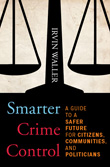Smart politicians must invest now in proven violence prevention. It is more cost effective than reactive policing and more jails. So the public interest calls for investment in what works to reduce violence, smarter use of current police resources and a shift to prevention from taxes wasted on over-use of jails.
The evidence – and my book Less Law, More Order – shows how helping youth at risk to flourish stops youth from becoming offenders who inflict pain later. At the same time, stopping offending avoids taxes mortgaged to pay for long term expenditures on emergency rooms, police and corrections.
The wealth of evidence and praxis that demonstrates that violence prevention is cost effective gets easier to access in plain English for politicians. It also gets stronger everyday.
Indeed, it is so strong that police leaders and even politicians at the highest levels repeat the conclusions. Earlier this year, no lesser a political leader than the British Prime Minister said that “Prevention is the cheapest and most effective way to deal with crime.”
Examples such as the violence reduction unit, in Glasgow, Scotland, show how this knowledge has been applied to reduce violence in high priority areas by 50% within 3 years. The carefully constructed auto theft suppression strategy in Winnipeg, Canada showed how an investment of $50 million led to savings from the reduction of car theft of several times that amount within five years.
Unfortunately, even a Prime Minister saying that prevention is cost effective is not enough to get the small but necessary investment – likely rising over two or three years to 10% of what we pay for police, courts and incarceration.
To get the investment, it is time to revisit the concluding chapters of Less Law, More Order, where I explained how small re-investments from incarceration could be used to launch and then sustain effective prevention actions at that 10%.
Incarceration as a scarce resource
For this investment to remain fiscally neutral, politicians must simultaneously limit the growth of incarceration. We know that a dollar of taxpayers money invested in early childhood or youth prevention will have the same impact on crime as $7 on the operation of prisons.
In Less Law, More Order, I called for a political decision to limit the number of prisoners incarcerated and so the costs of incarceration to taxpayers. Judges and the system would decide which offenders were the most in need of incarceration because of the danger, moral outrage or other legitimate reason. In essence, prison space would be treated as a scarce as opposed to an unlimited resource.
Incarceration has mistakenly been treated as different from other scarce resources such as hospitals. So judges sentence offenders to prison without any direct accountability for the costs. In striking contrast, governments have limited the number of persons who can go to hospital by making doctors set priorities. So why not change the legislation so that judges must consider the costs to the public purse of their sentences.
Recently a few marginal actions in Texas have attracted attention because politicians began to treat incarceration as a scarce resource. But much more is needed to realise the potential for large reductions in costs of incarceration to taxpayers. Politicians act as if this misspending is inevitable. They prop-up their inaction with misguided excuses for not investing in our safety. They point to jails that are overcrowded and powder kegs for riots but do not stop the flow into the jails. They dismiss prevention as not saving money without simultaneously taking action to limit expenditures on reaction.
Policing as a scarce resource
Policing is considered in the political mind as a tool to suppress crime. Yet politicians can access easily information of what works for policing. Yet they feel under pressure to put more boots on the street without looking at the evidence. It has become a largely reactive service where two thirds of its resources are used to respond to 911 calls and another 20% or so are allocated to detectives. The potential for using current police resources more effectively is significant.
Major cuts have even been made to police budgets in the UK. The public want more boots on the street but investments in prevention would make these cuts easier to manage and reassure the public that violence is being prevented. So I called in Less Law, More Order for a policy that would require a better allocation of policing resources rather than more boots on the street.
Conclusion
Somehow the legislators whom we elected to husband our taxes hesitate to put the potential of prevention together with controlling misspending on reaction. It is time for them to invest in preventing violence to get gains in public safety that can be realised in 3-5 years while simultaneously avoiding the pain to crime victims that may last a life time. But they must balance the investments in prevention with reductions in the unnecessary use of incarceration and so avoid the taxes wasted which could have been better invested in public safety strategies that are cost effective.

